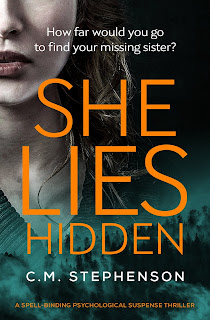She Lies Hidden by C.M. Stephenson #BlogBlitz #GuestPost
C.M. Stephenson joins me today on She Lies Hidden Blog Blitz to tell us about her writing day
The Book
How far would you go to find your missing sister?
How far would you go to find your missing sister?
When DI Thomasine Albright is informed that the remains of her fifteen-year-old sister have been found, she has the tragic responsibility of breaking the news to her mother. Thomasine promises her mother that she will be the one to find Karen’s killer.
But Karen Albright wasn’t the only girl to go missing during that weekend in 1973... Veronica Lightfoot disappeared too. They’d lived barely four miles apart, yet apparently never met. Suddenly there is a new question, was Veronica involved in Karen’s death? Is that why she vanished?
DI Mel Philips is handed the original case file and begins a new investigation. Unwilling to be side-lined, Thomasine decides to go it alone.
As the case unfolds, Thomasine realises that there may be other victims. Can she find them too?
C.M. Stephenson
My Writing Day
My writing day varies, if I’m on a deadline, I tend to wake early and, if I’m struggling to get back to sleep, I get up. This could be as early as four-thirty. Today I’m writing this at five-twenty-five. On days such as these I write in my dressing gown, reclaim my office chair (one of my cats thinks it’s his) and start work immediately.
If not, I wait until my husband has got up for work, around six-thirty, then read for thirty to forty-five minutes. I have a pen and pad by the bed and make a note of any particular words that leap off the page. My early morning reading is for self-development and inspiration. I’ll scan through something like Writing Fiction – a Guide to the Narrative Craft by Janet Burroway. My 1992 edition is well-worn and bought second hand. I love it. Or I’ll read a work of fiction (authors such as Maggie O’Farrell, Val McDermid and Jessie Burton to name but a few). These are generally novels I have already read, found to be beautifully written and want to learn from. Most recently, I was captivated by Educated written by American author, Tara Westover; a tremendous book that was an absolute page-turner. Although a memoir – it reads like a psychological thriller.
Also, if I’ve received a new copy of Writing Magazine I read through that.
Then I get up, make the bed and get ready for the day. I try and get a little housework out of the way before I start. The first thing I do is feed the cats, I have two. Then I feed me. After that I wash up, tidy the kitchen and anywhere that needs tidying, I might put some washing on. All are practical tasks that would plague me if I didn’t do them.
I like to be in the office by nine o’clock. This is a fairly simple commute as I work from home. I make myself a coffee, turn on the computer, have a quick glance at my planner and jot down anything else that comes to mind. This enables me to stay on track and also ensures that tasks progress and deadlines are worked towards. I like the discipline of it.
Unless there are more urgent priorities, the first hour and a half always dedicated to the previous day’s writing. In real terms, this means editing and polishing. Flashing things out, shrinking them back, looking for the right words, behaviour and dialogue. Before I adopted this approach, I would get caught up in the opening chapters, reworking them time and time again. Experience has taught me that there will be several drafts and if I keep trying to improve the beginning, it’ll take me a lot longer to get to the end. I set the alarm on my phone to make sure I keep to time.
I’m dyslexic and often horrified to see how many words I’ve missed out or misused, regardless of the fact that I know which ‘too’ or ‘to’ to use. Then I discovered Microsoft’s text to speech and life got somewhat easier.
When the hour and a half is up, I check my emails, Facebook and Twitter. I try and limit this to fifteen minutes. It’s easy to get lost in them.
After that I do new writing, that is the next chapters in the whatever project I’m working on. This involves jotting down a few ideas and then letting my mind go with it. I learnt a great deal from writing Where She Lies Hidden, especially about planning things out (I didn’t) and plotting (I struggled). Now I write a bullet-pointed outline of my initial thoughts on the plot and refer to that. The first draft is me telling myself the story. I literally close my eyes and write what comes into my head. That early version bears no resemblance to that final draft. Most often, I will write in 3rd person, chapter by chapter and in one document. Then I decide the point of view for each character and edit accordingly again. I am very fortunate to have people I trust to critique my work. They provide me with valuable, honest feedback, and I return the favour. For me, it is perhaps one of the most important parts of the process.
I usually work through until about two-thirty, then take a break. Then I will watch a crime drama – notebook and pen in hand. It’s one of the many ways I gather description. I make notes on dialogue, gestures, facial expression and voice. I examine the way actors interpret the script; my current favourite is Unforgotten – great writing and superb acting. YouTube is also an invaluable resource. For She Lies Hidden, I used it for research into brain injuries, Post Traumatic Stress Disorder, police interview techniques and for the case histories of missing people. I also speak directly to those involved in the areas of work I’m writing about.
Every few months, I like to treat myself to coffee and cake. Tea and coffee shops are a goldmine for detail. I usually spent a couple of hours observing how people move, gesture and talk. I take copious notes which I keep for reference purposes. I rarely leave home without a notebook and pen.
Every other day I back up my files to the Cloud. Once a week I copy the directory to a detachable hard-drive. That way my work is safe.
I finish work about three-thirty, hopefully after achieving my word target. Currently I’m aiming for 700-1000 words a day. Then I peer into the fridge and wonder what the hell I can whip up for dinner.
Life isn’t all work. We live in a very lovely part of the country and like to get out walking a couple of times a week. Plus, I meet up with friends. There is so much inspiration out there and I don’t want to miss it!
After growing up in a small Lancashire village, Christine Stephenson left school at fifteen. Four years later she moved to Cornwall.
In her late teens she met people whose lives were complicated, fuelled by drugs, and filled with violence and aggression. There were others too, in her mid-twenties, everyday people, educated, with careers, who had decent parents; people who you wouldn’t look at twice in the street. They were worse; she knew the victims of their crimes too. These experiences continue to influence her writing.
Her career can be described as eclectic. Jobs ranging from office junior to dental nurse, management consultant to executive and corporate coach. She ran her own training consultancy for over twelve years. It was there that her love of writing bloomed. She went on to produce an extensive portfolio of work which included resource packs, case studies, role-plays, games, presentations and academic texts.
In 2008 her husband’s job dictated that they move to South Gloucestershire. This in turn, lead to a brand-new life. They now live just outside a small medieval town, set between Bristol and Bath.
In 2009, she decided it was time to study the craft and undertook the A215 in Creative Writing with Open University, and later followed that with an MA Creative Writing at Bath Spa University, graduating in 2016. She gained representation with Andrew Nurnberg & Associates soon after. She spent the following eighteen months writing and editing what is now her debut novel. In May 2018 Christine was delighted to accept a contract with Bloodhound Books. ‘She Lies Hidden’ is due for release in September 2018.
Links:





Comments
Post a Comment